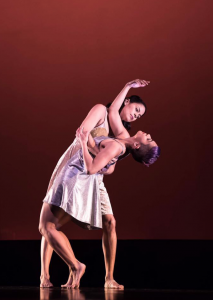Rite of Winter: Jean Isaacs’ “Janus II”

Photo: Doug McMinimy
Who’s going to die? In Jean Isaacs’ propulsive, stomping, ominous “Rite of Spring,” one dancer after another appears isolated from the rest … and will he/she be chosen to be sacrificed? Erica Ruse does a tortured, limb-flinging solo, while the others stand and watch. And these folks, denizens of a wonderfully creepy leather bar, doesn’t look friendly.
Trystan Loucado, bare-chested and wearing a dog collar, stalks through the crowd as if he could eat everyone for dinner. Cecily Holcombe, showing vitality in a scene that sometimes resembles a zombie apocalypse, is seductive yet vulnerable.
Moving as a group, the 12 dancers do a sideways walk, their arms stiffly crossing their bodies in the opposite direction, like figures on an Egyptian frieze. And when they explode into earthy squats, arms striking down like pile drivers, I have no doubt that when it comes time to slaughter someone, they won’t hesitate.
“Rite of Spring” was the pièce de résistance of “Janus II,” presented by Jean Isaacs San Diego Dance Theater at the Saville Theatre last weekend. Named for the Roman god of beginnings, transitions, and endings, the program offered new and old work by Isaacs—”Rite of Spring” is from 2002—and premieres by Trystan Loucado and somebodies dance theater directors Gina Bolles Sorensen and Kyle Sorensen.
The Sorensens have been building a strong body of work, and their “Seeker” starts with a bang. Annie Boyer strides onstage in red heels carrying a tray of cutlery, then tips the tray and lets everything crash. More crashing happens in some of the music, and the six dancers often writhe and twist, as if afflicted.
In an intriguing sequence, Zaquia Mahler Salinas stays on all fours while, in front of her, Desiree Cuizon-Fejeran and Brianna Bellamy do low-to-the-ground partnering, giving and receiving weight. Different dancers cycle into the roles, but there’s always someone on all fours.
Are they holding the space? And what’s with the abrupt ending? “Seeker” left me without the sense of coherence I’ve gotten from the Sorensens’ work in the past. I’d like to see this one again.
Loucado is primarily known as a striking dancer who performs both modern and ballet. His “Four Square” is the first piece I’ve seen from him, and it’s charming. A sort of noir fantasy, it involves four characters, all wearing white dress shirts and dark slacks, on a night street under a lamppost.
There’s a suggestion of narrative—maybe John Diaz is an author, and Cuizon-Fejeran, Zaquia Mahler Salinas, and Jeremy Zapanta are his characters?—and video in the style of silent-movie text with screwball content: “Let me alone. I’m looing for a piece of cheese, not a husband.”
The movement vocabulary is a bit thin, but Loucado uses it smartly. Cuizon-Fejeran and the sparkling Zapanta do a dance-off, and a bit with lyrical sweeping moves has a nonchalance that (along with the cinematic references) made me think of Gene Kelly.
“Four Square” has a sense of fun reminiscent of “Cabaret Dances,” the January program that Isaacs did for about 15 years. There’s a similar lightness to “Songs from the Family Album,” her 2017-18 work on this program.

Minaqua McPherson and Desiree Cuizon-Fejeran.
A series of five brief pieces, “Songs from the Family Album” opens with “Janus,” which explores the theme of looking to the past and future. Cuizon-Fejeran and Minaqua McPherson start out standing back-to-back, arms linked, and they remain connected—often physically and always via eye contact—in delicate adagio partnering that shows off Cuizon-Fejeran’s gorgeous extensions.
Isaacs’ family photos introduce the rest of the pieces, which are very much a family affair. Two pieces feature live music by Isaacs’ partner, Steve Baker, on piano, and her daughter, Liv Isaacs-Nollet—mainly known as a dancer—doing lovely vocals.
As they perform “Harvest Moon,” Matt Carney and Ruse do a sweet duet; it’s as if they’re slow-dancing at a party, but he’s holding her so her feet don’t touch the ground. And isn’t love like that?
“Cabaret Dances” lent itself to lighter artistic fare—like the cocktails and nibbles that were served—and sometimes left me wanting more substance. With “Janus II,” Isaacs provides a satisfying menu of light and dark, love and death.

Award-winning dance journalist Janice Steinberg has published more than 400 articles in the San Diego Union-Tribune, Dance Magazine, the Los Angeles Times, and elsewhere. She was a 2004 New York Times-National Endowment for the Arts fellow at the Institute for Dance Criticism and has taught dance criticism at San Diego State University. She is also a novelist, author of The Tin Horse (Random House, 2013). For why she’s passionate about dance, see this article on her web site, The Tin Horse

Thank you for this brilliant write-up. Descriptive and poetic.